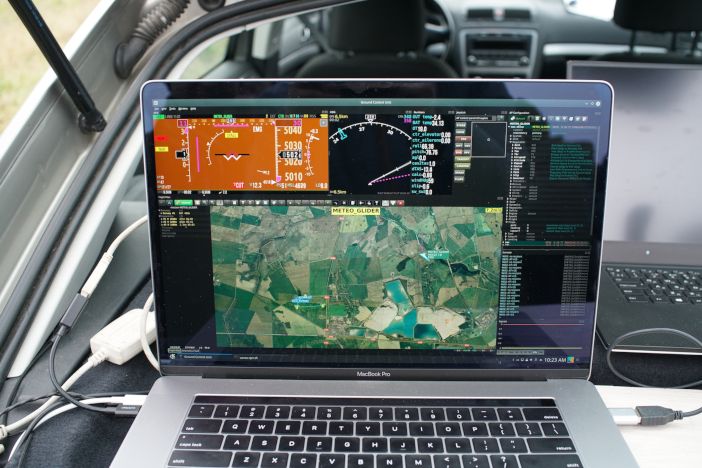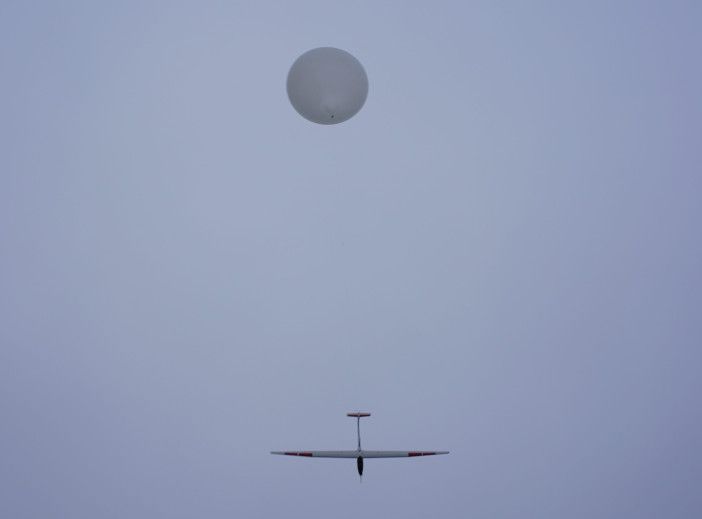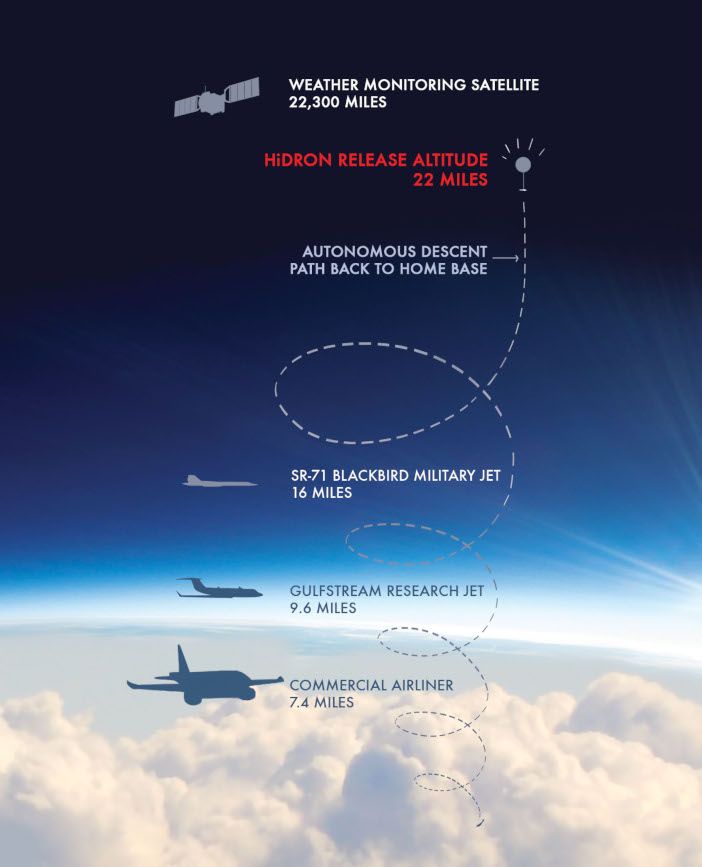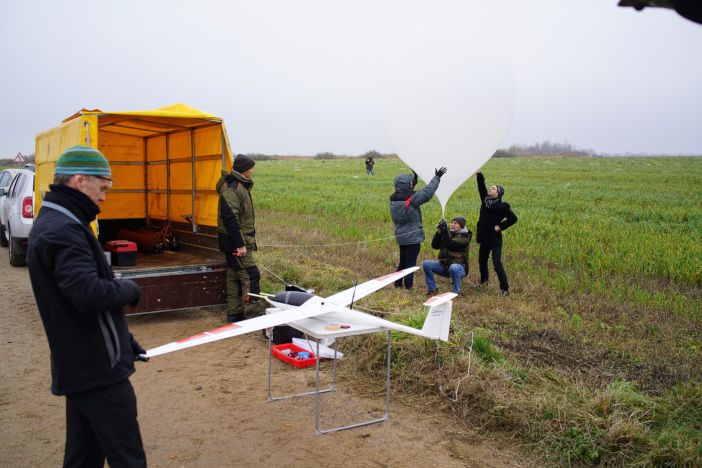A new type of drone which is launched by balloon into the stratosphere has successfully reached an altitude of 82,000ft during test flights in Europe, opening up the possibility of new types of atmospheric and meteorological research to scientists for the first time.
The Hidron stratospheric aircraft ascends through the atmosphere on a weather balloon, is released once it reaches its target altitude and then glides slowly to a pre-programmed landing zone over several hours. The drone collects data while descending using a payload of sensors and instruments, which meteorologists and climate scientists can then analyze.
The developers, Uavos and Stratodynamics Aviation, believe Hidron will open up new research applications in the stratosphere because it is cheaper to operate and produces more and better data than other methods.
The single-use balloons currently used by atmospheric researchers often result in the loss of the equipment, whereas Hidron is recoverable and reusable.
Design and construction
The Hidron is made of composites, has a wingspan of 3.3m (11ft) and weighs 5kg (11 lb). It is designed to carry an in situ measurement instrument weighing up to 1kg (2.2 lb).
The fixed-wing glider does not use engines or propellers, although there is a battery to power the telemetry, payload, autopilot and servo drives for the ailerons and tail rudder.
Data from the integrated instrument is transmitted via telemetry immediately during the ascent to a ground station, like a weather radiosonde.
After it reaches the desired altitude, set by the ground station operator, the Hidron disconnects from the balloon and glides back to a pre-programed landing site. Changes to the flight plan can be made by the operator in real time. Algorithms automatically process efficient flight controls to maintain optimal energy and to increase the flight duration. The landing of the aircraft is fully automatic.

All operational parameters are transmitted via radio telemetry with a range of 66 miles (100km). An iridium satellite link provides a back-up communication system and there is a deployable parachute and a dual redundant balloon release system.
Test flights
Hidron’s maiden flight took place during November 2018 and lasted for 1.5 hours. It reached an altitude of 20,000ft and its vertical speed as it descended was 6.5ft/s (2m/s).
The night-time flight conducted earlier this month lasted for four hours, including a one-hour balloon launch period which had an average climb rate of 22ft/s (6.8m/s). At release altitude, the Hidron was 22 miles (36km) from the launch site.
A night-time flight was performed to minimize the impact of the test on commercial air traffic. The Hidron passed through commercial airspace twice, on the ascent and descent, and an adjustment to civilian aircraft routes was made during flight window.
The system allows for multiple ground control stations, which can be synchronized from different locations and a backup live-linked ground station and operator were stationed at the Air Traffic Control center.
This enabled the mission team and air traffic control staff to track the aircraft’s position from the ground station and on-board transponder. Air traffic control staff indicated the transponder was sufficient for subsequent flights.
The Hidron was found to perform well during the flight in standard operational modes and in challenging BVLOS (Beyond Visual Line Of Sight) conditions. It operated in headwinds up to 112mph (180km/h) and -60°C (-76°F) temperatures, experienced wing icing, and reliably returned home and landed autonomously.

Areas closely monitored during the test flight included flight stabilization after balloon release and the performance of controls and components for stratospheric flight. During the flight, operators also checked the performance of the Hidron’s avionic systems, flight characteristics, safety features, instrument integration, and auxiliary tracking systems including a transponder.
Engineers also tested automatic up-stream processing software designed to increase the descent time depending on the weather conditions.
Aliaksei Stratsilatau, Uavos lead developer, said, “We also undertook studies of the descending wind stream structure in the stratosphere to increase the duration of the Hidron flight. In addition, our specialists developed a control and tracking system for an unmanned aircraft in real conditions within commercial air traffic space, which confirms the project’s readiness for commercial use.”
Data collection
During the latest test flight, Hidron’s payload included meteorological and atmospheric instruments and sensors that were integrated with the autopilot telemetry and custom fitted to the aircraft. An atmospheric measurement system was provided by researchers from the University of Kentucky.
Data was successfully collected at the ground station in real time and compiled with the flight records.
Engineers evaluated the integration of the instrumentation during the test flight and although areas for “further refinement” were identified, the onboard measurement system was deemed to have performed well and demonstrated operability in high winds, cold temperatures, and low air density conditions.

Marcelo Guzman and Travis Schuyler are researchers from the University of Kentucky. Guzman said, “One of our project goals is to better understand meteorological and weather forecasting models by measuring atmospheric conditions during high-altitude aerial vehicle flights, and we are very excited to share the data collected using the Hidron with the Scientific community.”
Travis Schuyler said, “This is the first time that this kind of atmospheric-sensing equipment has been integrated into a balloon-launched, unmanned glider and the results will enable the evolution of new UAV technology and in situ observation methodologies.”
Gary Pundsack, founder and CEO of Stratodynamics Aviation, said, “The Hidron performed well in challenging winter winds and night conditions. At the 25km launch altitude, the Hidron traveled 36km from home. The return glide was controlled and, at an altitude of 18km, the Hidron was above the home position where it loitered in a slow descent down.
“Even with a build-up of ice on the wings, from passing through low-level clouds, the Hidron landed autonomously. The test demonstrated the Hidron’s aerodynamic capabilities and avionic system reliability.”
Next steps
The next stage of testing will assess how the sensors, instruments and aircraft perform at an altitude of 98,000 ft.
Pundsack said, “We’re breaking new ground in BVLOS. Part of our mandate is to generate flight data that will help to inform policy for BVLOS in Canada. It’s very exciting because we are flying in the stratosphere, which in so many ways, is an undiscovered country.”
Stratsilatau, added, “One of our main objectives is to stabilize the transmission of data, the interaction of the autopilot with the payload and the control of Hidron in the stratosphere. We are also practicing how the drone interacts with air traffic control organizations. A challenge has been coordinating with the licensing organizations for flights, because the aircraft ascends as a meteorological probe, but descends as a UAV.”
“Many from the scientific community are interested in Hidron,” added Pundsack. “Opportunities to access the stratosphere are few and far between and require a large investment. Most balloon lift-and-drift platforms offer no guarantee that the payload will be retrieved and are at the mercy of the weather, time of day and time of year. Hidron disrupts the model with its versatility, control and quick lead time to launch.”





